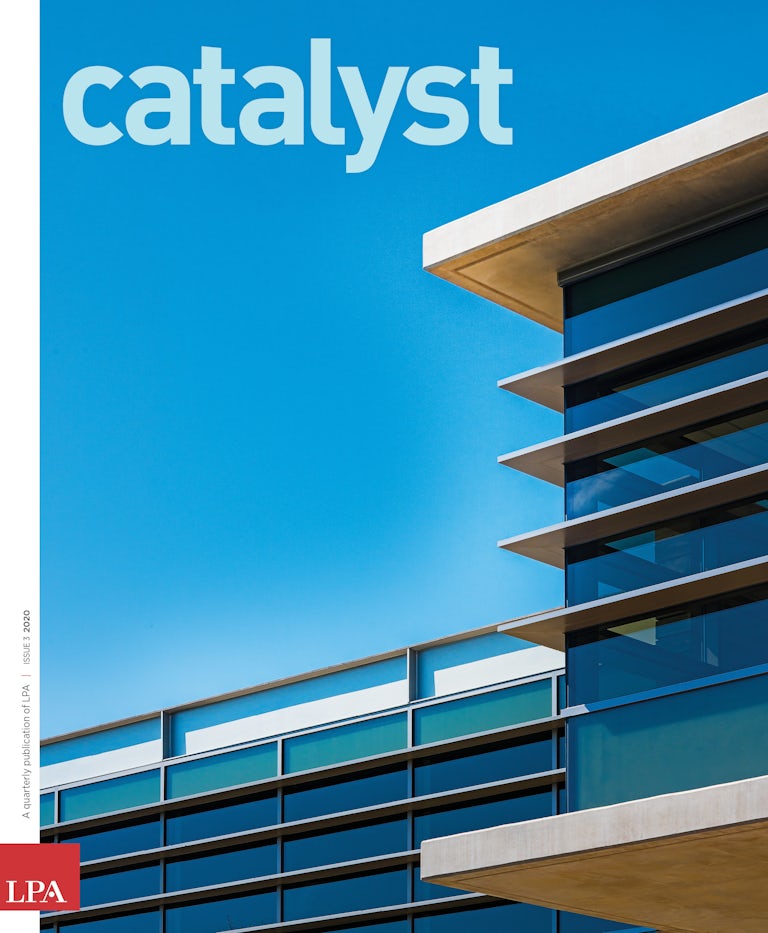The new police service headquarters for the City of Salinas is the result of years of planning and debate. The planning process began with dozens of community meetings that engaged a range of local groups. Beyond meeting the needs of the department, the project is designed to reflect the community and rejuvenate the neighborhood.
“When you build a civic project like a police station, you’re holding a mirror up to the community,” says LPA Director of Civic + Cultural Jeremy Hart. “If you’ve been successful, the community will embrace the project and know it represents them and their values.”
The project, developed as a public-private partnership with Griffin Structures and Swinerton, created a modern facility for the police department, addressing the city’s operational requirements and long-term goals. The facility provides a new welcoming environment for the public, with a level of safety and security that did not exist in the older facility.
A New Public Safety Headquarters for the City of Salinas
The community helps shape a modern facility that raises the bar for the police department and creates better spaces for the public.

“The final product that you see today was overwhelmingly the product that our community wanted to see.” - Matt Maldonado, Salinas Commander and Assistant Project Manager
“The final product that you see today was overwhelmingly the product that our community wanted to see,” says Salinas Commander Matt Maldonado, the assistant project manager.
The new headquarters replaced a 60-year-old facility that had long outlived its effectiveness. The process of creating the new headquarters started in 2013, when LPA and consultant MWL Architects, were hired to prepare a needs assessment, draft a program and create a series of initial studies of potential sites.

The new facility is actually two buildings. A two-story, 44,352-square-foot headquarters structure houses administration staff, investigators, support staff and all first responder functions. The building is designed and engineered to meet California’s Essential Services Buildings Seismic Safety Act, providing the resiliency necessary for the essential 24/7 public safety operation.
A second, 24,878-square-foot support building includes state-of-the-art evidence storage areas, a forensic laboratory, SWAT training and ready rooms, and a customizable firearms proficiency and training facility.Shifting the nonessential functions into a different building helped reduce construction costs and create more opportunities to develop specialized training and investigation spaces. The primary building was designed with concrete tilt-up panels, which also helped reduce construction time and expense.

The facility brings a new level of technology and flexibility to the department’s operations. The forensic lab is “state of the art,” says Commander Stan Cooper, who helped oversee the project before retiring earlier this year. “It’ll give us not only a better ability to do what we’re doing now, but we’re also looking at state and federal certification for that lab down the line, which we would not have been able to even come close to in the old facility.”
Within the facility, the design focuses on each department’s specific needs and procedures. Related departments are internally connected, and the layout is designed to facilitate efficiency and improve cohesion.
The infrastructure of this building was “designed with a specific intent for workflow,” Maldonado says. “It’s also going to make our interaction with the community and our service to the community light years ahead of what we were doing at our old building.”

The design focuses on each department’s specific needs and procedures. Related departments are internally connected, and the layout is designed to facilitate efficiency and improve cohesion.
The extensive community engagement significantly influenced the exterior design. Members of the community were able to examine different ideas and vote on their favorite elements. More than 25 local groups were involved in dozens of meetings and workshops that ranged in size from 10 to 75 individuals. Special attention was paid to the outdoor areas and spaces where the public and police officers interact.
The plaza in front of the facility provides areas for community events and spaces for food trucks. A community room sits at the corner of the building, with an operable wall partition that opens to a courtyard and covered arcade. The arcade was a response to the community’s desire to tie the building into the community’s Spanish heritage, using the mission-style arch in a modern way.
Throughout the design, attention was paid to the many public functions handled by the headquarters. The design creates areas for safe transactions, and the lobby presents a warm presence for people who are there for routine fingerprinting or to file a complaint.

“A police service facility provides many important civic services,” Hart says. “The public spaces need to strike a balance between being comfortable and inviting and providing safety and durability.”
The finished design creates a compact footprint on a 5.5-acre site, saving adjacent land for new community-focused development. The city has discussed many ideas, using the new police services headquarters to spark more activity in the neighborhood.
“These projects are large capital investments for a community,” Hart says. “It is important that we are good stewards of the taxpayers’ money.”
















